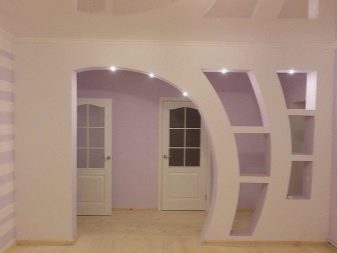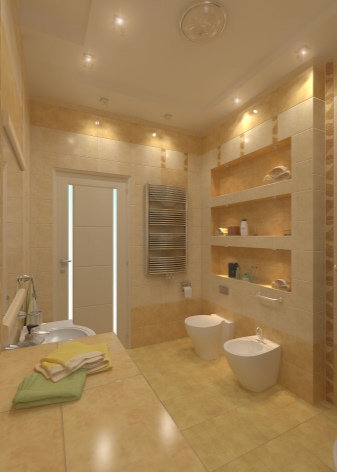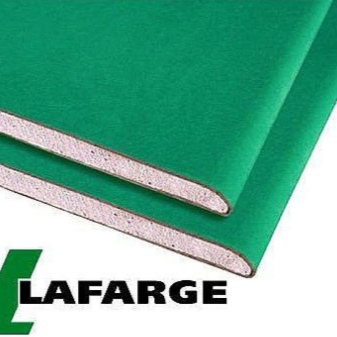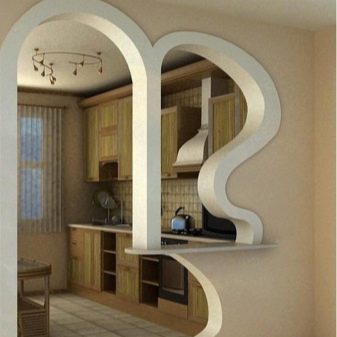Plasterboard structures: types and step-by-step manufacturing

Plasterboard constructions occupy a special place in modern interiors, as they are an original addition to any setting. From this material, you can make both simple and complex models, ranging from pieces of furniture to partitions and ceilings. Drywall is simple and versatile in work, so it is quite possible to create unique elements from it with your own hands, without having certain skills for this. In addition, the material is presented in various types, which makes it possible to use it indoors, regardless of their temperature regime and humidity level.


Peculiarities
Drywall is considered a unique building material, which is produced in the form of sheets. Due to its special structure and flexibility, it can be applied to any surface, decorating the interior of rooms with interesting design ideas. The most popular plasterboard structures are suspended ceilings and arches. Since the material is lightweight, it does not need additional surface reinforcement and is quickly assembled. To make curly parts from it, it is enough to first draw the diagrams, cut the elements along them and fix everything.


The main feature of drywall is that it easily changes shape when it gets wet. Thanks to this quality, it can be used not only for the implementation of any ideas in the interior, but also for leveling surfaces.
If we consider the advantages and disadvantages of drywall structures, then it is worth noting that they have many advantages:
- create even coatings, at the end of finishing, the material acts as an ideal base for painting, ceramic tiles and wallpaper;
- allows you to make parts of various shapes;


- high air permeability and environmental friendliness;
- good sound and heat insulation;
- fire resistance and strength;
- affordable price.


Despite the positive characteristics, drywall has one drawback - it's fragility. Therefore, it is not recommended to install it on walls that are exposed to mechanical stress.


Views
Plasterboard structures are boxes sheathed with sheets and decorated with decorative cladding. They are used for interior design, the result is a beautiful interior, and the rooms are filled with home comfort. Plasterboard compositions can be complex, simple, curved, even and enclosing.
Depending on the scope of their use, the following types of structures are distinguished.
- Ceilings. In order to align the ceiling tiles, simple single-level systems are installed. If you need to decorate the room in an original way, then choose multi-level ceilings, consisting of many curly inserts, lighting and stretch fabric.


- Walls. From drywall sheets, you can perform as a simple finish and hide all surface defects, or you can apply decor and create chic partitions for zoning a room. In addition, "full-fledged" walls are also constructed from this material, which help to separate one room from another.
- Arches. Recently, decorative arches have been very popular, which, unlike ordinary interior openings, can have a trapezoidal, rounded and rectangular shape. Arches in the form of an ellipse look beautiful, as well as installed in a semicircle


- Furniture. Plasterboard is often used to make bookshelves, shelves and special niches in the walls. In addition, it is also possible to create a bar counter, wardrobe and a small wall for the hallway or living room. Furniture made from such material turns out to be not only stylish, but also multifunctional. At the same time, it is recommended to use moisture-resistant sheets for rooms with high humidity, from which you can build shelves in the kitchen for storing things or a niche for appliances.
- Decorative boxes. They are installed to hide cables and various communications. Plasterboard ideally aligns window and door slopes or close the ventilation system.
- Decor. Since this building material is easy to finish, it is often used for the manufacture of columns, false fireplaces and geometric niches.


Dimensions (edit)
Usually drywall sheets are produced in a standard size of 2500 * 1200 * 12.5 mm. In addition, many manufacturers produce sheets with a width of 1.2 m and a length of 2 to 3.6 m. The thickness of drywall can also vary from 6.5 to 12.5 mm. To choose the right material, you need to know not only its dimensions, but also take into account the type of surface that is planned to be covered with it. So, for example, to create parts of a complex structure, it is recommended to purchase an arched drywall, its thickness does not exceed 6.5 mm, thanks to which the product is able to bend to any radius.
In the case when it is necessary to build partitions, niches or align walls, then it is better to give preference to wall plasterboard, the thickness of which is 12.5 mm. As for the installation of ceiling structures, ceiling plasterboard with a thickness of 8 to 9.5 mm is ideal for them. Outwardly, it does not differ in any way from ordinary material, but it has a small weight.

Colors
Plasterboard is produced in a wide range, it is considered one of the most demanded materials in construction. Each type of product differs not only in its size, but also in its properties and technical indicators. Going to buy drywall, you need to pay attention to the fact that it is sold in various colors, which indicate the properties and scope of the material. It should be noted that the color scheme does not affect the appearance of the finish.

Gray drywall is usually chosen for the installation of interior partitions and for leveling the walls., it is made of cardboard and gypsum with a thickness of 12.5 mm. It is considered the cheapest option for cladding surfaces in rooms with normal humidity and temperature conditions. Green sheets are characterized by a high level of moisture resistance, therefore they are recommended for installation in rooms where the air humidity exceeds 70%. Red and pink drywall is highly resistant to fire, it is used for cladding ventilation systems and fireplace structures. The presence of a yellow color on the surface of the material means that it can be used for cladding facades and foundations that are constantly exposed to the negative effects of moisture, sunlight and drafts.

Style and design
Various designs are made from drywall sheets, which act not only as an original interior decoration, but also allow you to divide or combine several zones in a room. Recently, arches can be found in many apartments, they are a stylish transition between rooms and, unlike ordinary doorways, harmoniously fit into all design styles. To make such a structure complete, it is additionally decorated with wallpaper or masonry.


There are also many design options for drywall niches. Their design can be of different depths, sizes and shapes. Various decorations in the form of figurines, flowers, vases and toys will help to give aesthetics to niches. In addition, their finishing provides for the installation of lighting and colored glasses. In the kitchen and bathroom, the walls sheathed with plasterboard are usually finished with ceramic tiles or materials with imitation of stone and bricks.


How to choose and do it yourself
Before placing drywall structures in a renovated room, you need to draw up an accurate diagram indicating the size and location of the parts.
Collecting elements with your own hands is not difficult, but it is advisable to do this, adhering to certain rules, the following step-by-step instructions will help with this.
- The first step is to determine the center of the room and mark the guides. Then the profiles are attached to the places indicated according to the diagram. For the installation of the arches, the profiles are additionally reinforced with racks, observing a step of 20-30 cm.
- At the second stage, the upper guides of the structure are fixed.



- The next step in the installation is to work with sheets of drywall, from which the necessary structural details are prepared. Before bending the material, it must be moistened with water, this will allow you to get the maximum radius of the figure.
- The final stage. The protruding material residues are cut off with a knife and the resulting part is putty. In order for the structure to acquire a flat and smooth surface, it must also be treated with a primer and all seams must be carefully sealed with putty.


Depending on the type of room, various design ideas are used in the form of installing a false ceiling, niche or partitions. With the help of drywall, the interior can be decorated in the following rooms:
For the living room
In the event that the room has high ceilings, then multi-level suspended structures that can be decorated with various colored inserts and artistic painting will look perfect in it. In a small drywall room, it is recommended to arrange a niche for a TV, into which you can also build an aquarium. Plasterboard shelves, which can be installed near the sofa and equipped with lamps, also look unusual in the living room.



Into the bedroom
This room requires a special approach in design, so simple shapes and clear lines should be present in its interior. In the bedroom, drywall will look original not only on the ceiling, but also on the wall. It is good for them to decorate the head of the bed, creating a false wall and decorating it with profiles under a wooden beam. You can also make stylish bedside shelves and bedside tables from drywall sheets, with bright lighting they will create a romantic atmosphere in the room.



In bathroom
For cladding surfaces in the bathroom, only moisture-resistant material must be used. Plasterboard structures in this room can be different. If the room is small, then it is possible to install a suspension system of a simple design in it or sheathe only half of the ceiling and the sink with it. At the same time, ceiling structures with LED lighting look gorgeous.


For the hallway
The interior of this room can be complemented in an original way by any plasterboard structure, the choice of which largely depends on the area of the room. As a rule, arched structures are installed in the hallways, which allow you to create a modern design. In addition, in such rooms there are often multilevel ceilings and false walls made of plasterboard.


To the kitchen
Since a lot of steam is released in the kitchen during cooking, it must be finished with moisture-resistant plasterboard sheets. It can be used to build partitions or make corner cabinets. Well suited for the kitchen and such a plasterboard structure such as an arch.


Required tools and accessories
Plasterboard decorative parts are an original decoration of any interior, but in order to install them, it is necessary to choose the right material, but also the appropriate tools. For strong fastening of the structure, it is placed on a frame, for the manufacture of which a cutter 0270 and metal U-shaped profiles with a length of 3 to 6 meters are used. In addition, to create a frame, guides and support profiles are also required, thanks to which you can form the desired angle of the metal structure under the gypsum board.


As for additional fasteners, they include suspensions, screws and dowels. Structures are sheathed using sheets of SP 55 101 2000. Since the details of the structure must be of the correct size, they are cut with a knife. Also, for work with drywall, you will need a tape measure, a level, a needle roller and a ruler.

Tips & Tricks
In order for the repair of the premises at the end of the finishing work to please with a high-quality result, plasterboarding of surfaces with plasterboard must be carried out correctly. This also applies to the installation of plasterboard structures.
If the interior design is done by hand, you must follow the following recommendations.
- It is necessary to use drywall for finishing, which has a flat surface. If microcracks are visible on the sheets, then such material is considered unsuitable for work.
- Installation should be carried out in a room with a temperature of at least + 10C.
- It is necessary to cut the sheets with a respirator and glasses.


- The material should be purchased taking into account the level of humidity and temperature in the room.
- Do not fasten the sheets with nails.
- It is not advisable to hang heavy shelves on drywall walls.

Manufacturers and reviews
Today, drywall is presented on the construction market by both domestic and foreign manufacturers.
At the same time, the products of the German company received many positive reviews. Knauf, which has factories not only in Germany, but also in Russia.
Plasterboard production is in great demand Lafarge Group (Poland) and Gyproc (Scandinavia). The material has proven to be of high quality, it is durable, moisture resistant and easy to install.


Russian-made products are also popular. JSC "Gips" and "Gipspolymer"... Choosing drywall from these manufacturers, you can be sure that the finish will last a long time and reliably.


Successful examples and options
In a modern interior, there are many ideas for the use of plasterboard structures, since the surface decorated with plasterboard finishing can be additionally finished with ceramic tiles, wallpaper, plaster or decorative stone. Illuminated multi-level ceilings look gorgeous in apartments and houses, they harmoniously fit into the design of any room. They can be decorated with various curly elements in the form of spheres, cubes and flower arrangements.


An interesting option are drywall structures built into the walls or located separately. In addition, arches made in the oriental, gothic or classical style are also in demand in the interior. The original shape of the arch and the right finishes make living rooms, hallways and bedrooms cozy.


How to make a drywall arch, see the video below.













The comment was sent successfully.